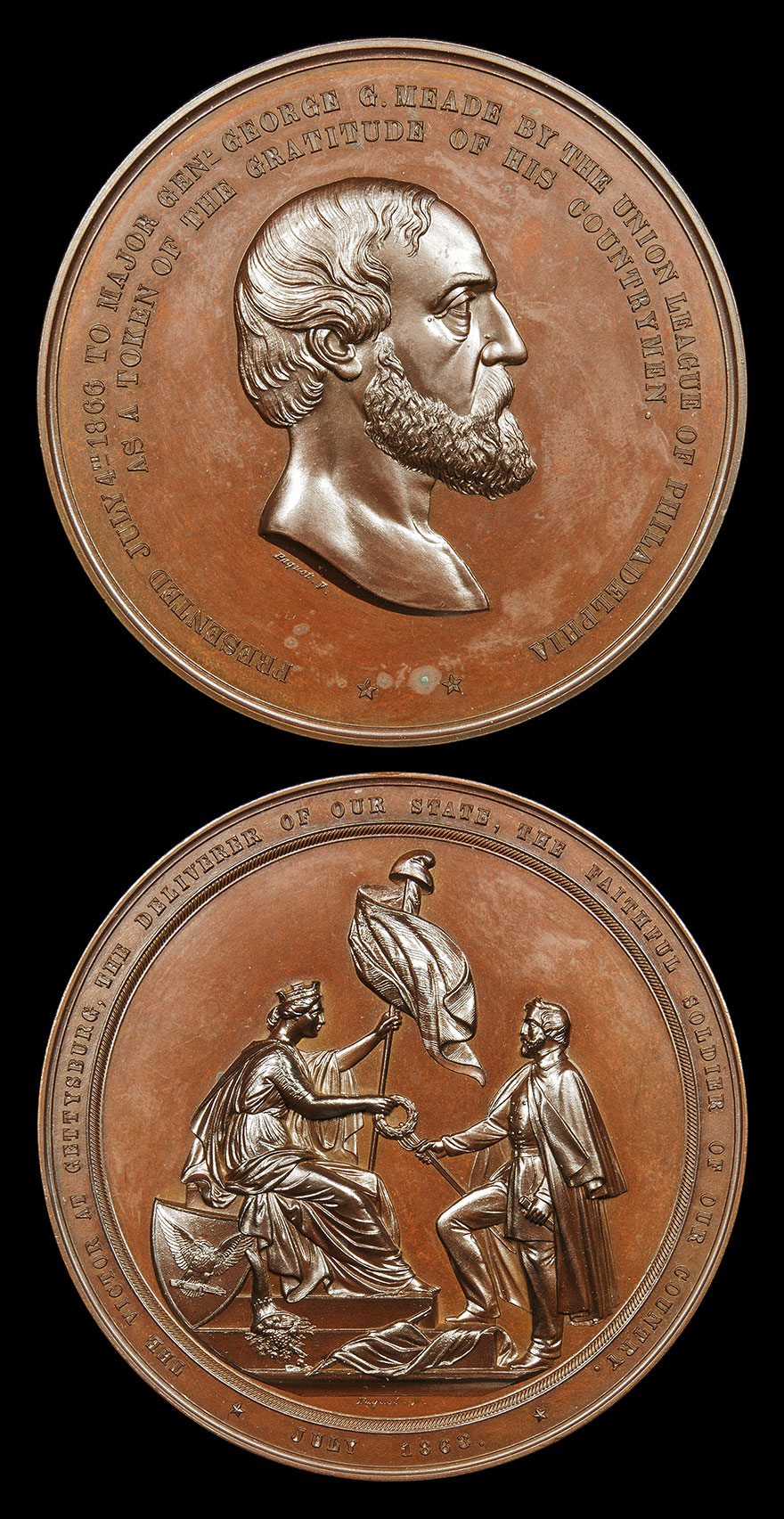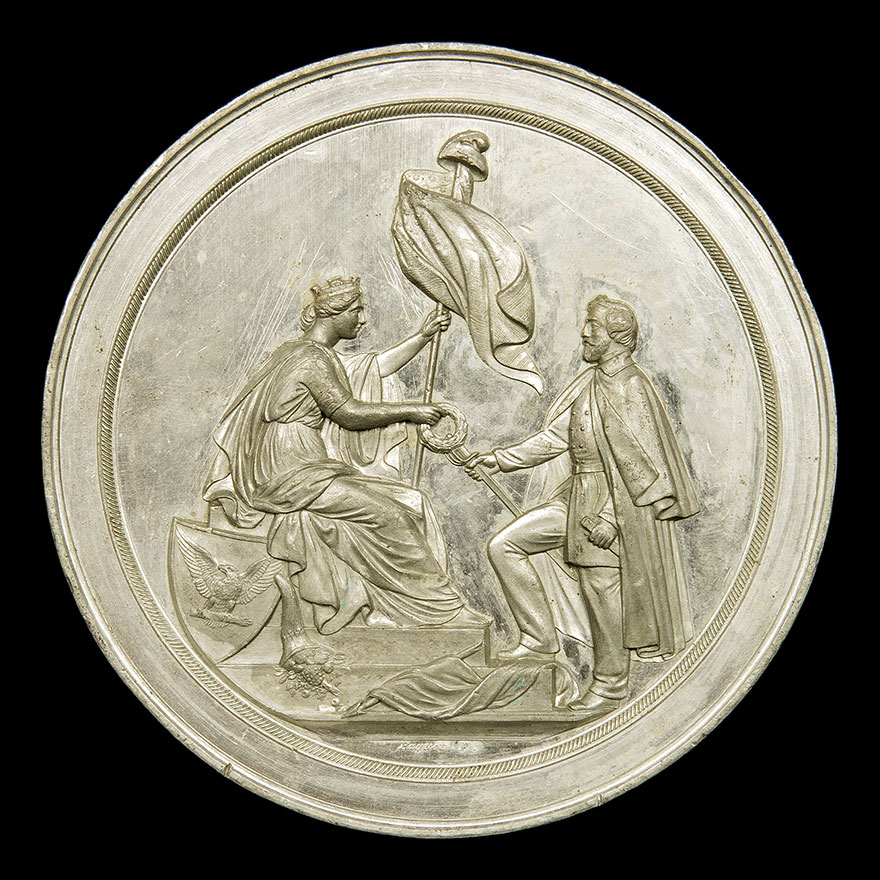Anthony Conrad Paquet - German-American Engraver
There were a lot of great engravers from Germany in the 1800s including those that moved to the US and those that made US-related works from Germany.
Anthony Paquet was a German born engraver that moved to the US, set up a private engraving practice and then worked for the US Mint.
The following is his bio from the NNP: https://nnp.wustl.edu/library/PersonDetail/1503
Born in Hamburg, Germany. Came to America in October 1848. He worked in Philadelphia 1850 to 1855 and in New York City 1856 to 1858, then returned to settle in Philadelphia.
He was Assistant Engraver of the Mint starting October 20, 1857. He left his official position in 1864. He died in Philadelphia. Paquet produced dies for a new reverse for the twenty dollar gold pieces beginning in 1861. A few were struck and released before the dies were withdrawn because the rims were too narrow. He engraved dies for the first Congressional Medal of Honor.
In reading about Pacquet, I came across the following which I thought was interesting:
Believed to be the son of bronze-worker Toussaint Francois Paquet, Anthony C. Paquet was born in Hamburg, Germany on December 5, 1814, and arrived in Philadelphia in 1848. In the mid-1850s, Paquet opened an engraving business in New York, during which time he is believed to have struck several medals, apparently all unsigned, except for THE ROCKY MOUNTAINS ECHO BACK FREMONT campaign medal. In early 1857, Paquet took up contract work for the Philadelphia Mint before finally being hired as an assistant engraver. His projects at the Mint were mostly pattern coins, once again unsigned, including a fascinating copper double eagle pattern, Judd-257.
It's interesting that he signed just a single medal which is shown below. This one is from Virgil Brand's collection.
Anyone follow or collect Paquet's work?

Comments
@Zoins.... Nice medal and thanks for the Pacquet history. Surprising that there is only one signed product. Cheers, RickO
I love history and finding people's full names. A middle initial just begs for a few Google searches
I was unsuccessful finding his middle name searching for his name, but was successful searching for his father's name where I found out he was born as Anton Conrad Paquet. It would be good to add this to his NNP bio.
The following is from "Coins and Currency: An Historical Encyclopedia, 2d ed." by Mary Ellen Snodgrass:
Found online via Google Books.
He signed more than one medal -- Pacquet's signature is on a number of medals that he designed while employed at the U.S. Mint in Philadelphia. He (along with William Barber) is responsible for most of the miniature medals in the Presidential Series (Julian PR-25 through PR-45) with his initial P appearing on the truncation of the bust on many of the combinations. Some of these dies also moved in and out of the U.S. Mint to private die sinkers with the signature initials often being removed for the private usages of the dies.
The article specifically refers to his privately issued medals, but this brings up a good point. Is the above the only medal with his full last name "Paquet"?
And how does one remove an initial from a die? Is the die filled in somehow?
Excellent posting, thanks. Being of shared German heritage I now have one more reason to appreciate my Double Eagle Reverse Paquet.
FWIW my Great Grandfather who also came to this country in the 1800s contributed by building the largest log house in the State of Nevada. (It was moved from its original location in Sherman, Nevada to Elko, Nevada where it currently houses the Elko Chamber of Commerce.)
That's awesome! Here's a modern rendition.
Medal of General Meade by Paquet (and signed Paquet on the obverse and reverse):

Reverse die trial (lacking surrounding inscription):

Virtus Collection - Renaissance and Baroque Medals
He was IMO a great medalist. Probably my three favorite medals of his (I have none) are the Indian Peace Medal for Andrew Johnson, the St Peters/Pauls Cathedral medal (Wiener style), and his Crystal Palace fire medal.
And scrolling thru the ANS listings, how could I forget the George Robinson medal?
Ed. S.
(EJS)
That's a gorgeous medal!
I do think the author was intending the article to say the Fremont piece is his only private pre-US Mint employment medal that was signed.
Regarding the medal in the OP, John Kraljevich indicates a bronze version was struck by the US Mint and listed in Julian but the white metal one may not have been struck in the US Mint.
Was this political medal privately created and then contracted to be struck by the Mint as a private contract?
https://www.jkamericana.com/remarkable-john-c-fremont-medal-by-anthony-c-paquet.html
I agree with Aegis3.
Very good at what he did.
One of my favorites.
Here's a signed Paquet medal of St. Peter & St. Paul Cathedral in Philadelphia dated 1864.

Got this almost a year ago and came in original case.
A gold medal by him just sold at heritage yesterday. I had my eye on it, but it went over my max before I put in my bid. It is very nice, but I didn't think it was worth the more than 10K it went for. Although it has about 5K in gold.
https://historical.ha.com/itm/military-and-patriotic/2nd-type-gold-lifesaving-medal-50mm-by-paquet-awarded-to-george-lee/a/6229-40231.s?ic10=AllCategoriesResults-ItemImageDesc-050517
I'll add some links to the ANS holdings for the four medals I listed.
Johnson Indian Peace medal
Cathedral
Crystal Palace fire
George Robinson
Ed. S.
(EJS)
Excellent story. Knowledge is a good thing
I'd like to think it's worth $10K. It's beautiful, large and gold.
i just saw some Don Patrick Hard Times tokens go for $9K.
Impressive!
That is a good point. I take it back, I think it was well worth the 10K, I might even had stepped up for it but I didn't like the Black spots on it.
They were buying some military buttons at the same auction for over 10K. I would much rather have a big gold medal, than a little button that was on some uniform.
Are any of Paquet's original dies known to exist?
That bio is somewhat incomplete, because Paquet also produced the hub for all the 1859 (Philadelphia) half dimes.
This hub is often described as having "hollow stars", but the entire figure is thinner, and LIBERTY on the shield is taller.
It's essentially a one year type.
It was also used in the 1859 and 1860 pattern half dimes, known as "a coin without a country" which were missing UNITED STATES.
Compare with the 1857-1858 and 1859 New Orleans hub.
(Photos from PCGS CoinFacts and Stacks Bowers Auctions).
He produced dies for several other denominations as well:
https://uspatterns.stores.yahoo.net/anthonycpaquet.html
For example, the 1859 quarter Type 2 Obverse and Reverse dies:
https://forums.collectors.com/discussion/1055318/1859-seated-liberty-quarter-type-ll-ll
The only time I purchased an item because Paquet had made the die for it was when I bought this 1859 half dime. The coin is nothing special; it's just an EF; but I wanted an example of it.
As it was with the 1861 $20 gold piece, I think this piece has design flaws. The shape of the Seated Liberty reminds me of a ship's bottle, and the hollow spots in the stars are odd. For whatever reasons, Paquet did not seem to have much luck with producing dies for regular issue coins.
The other Paquet pieces I have are in my collection because I wanted them for esthetic or historical reasons. Paquet produced the dies for this 1856 James Buchanan presidential campaign medal. It is listed as DeWitt/Sullivan variety JB 1856-1. Unity among the states was a huge issue in the 1856 campaign. The major politicians realized that the country was on the brink of disunion.
I also have an interest in many of the medals that are listed in R. W.. Julian's "Medals of the United States Mint, the First Century 1792 - 1892.” This mint cabinet medal was one of the first pieces that I acquired from that series. It is one of Paquet's works.
Wow, great info @yosclimber and @BillJones !
So, how is Paquet's last name pronounced?
An authorized PCGS dealer, and a contributor to the Red Book.
Pa - kay
This is an interesting 2 Headed pattern J-253 (a fantasy piece). The Liberty Seated is recognized as Paquet's work while the "FRENCH HEAD of Liberty " is by Longacre's. However, on the web site USPATTRN,COM, they state that "Saul Teichman, .... has always questioned whether the French head was designed by Longacre or Paquet as it used Paquet's punches in the legend "United States of America"."
I think this is just a slick piece.
OMG ... My Mother was Right about Everything!
I wake up with a Good Attitude Every Day. Then … Idiots Happen!
Very nice! It's great to see this two headed / double dated piece!
Here's one from CoinFacts, along with another similar Paquet design.
1859 Double Eagle by Anthony Conrad Paquet
Catalog: Judd-253
Cert: https://www.pcgs.com/cert/40276438
1859 Double Eagle by Anthony Conrad Paquet
Catalog: Judd-257 Gilt
Cert: https://www.pcgs.com/cert/40275024
Here's one without a date, but with an eagle. It's neat to see how these designs evolve.
I agree these are a hoot ... I did pick up a J257 in an NGC holder as a PR63 and it is a very sharp design when inspected in person.
The J253 that you referenced is the Simpson piece picked up by a dealer and still being offered. H. Bass has a nice looking piece that was in the ANA Museum collection that I believe will be on the market when Heritage auction them off.
USPatterns.com estimates there are a half-dozen pieces known, and they further state three are impounded in museums ( 1 being the Bass piece).
The others
4) B/M 11/87, Lemus-Queller, Heritage 1/09 - NGC65, illustrated above
5) Eliasberg - gem proof
6) Kentucky collection - NGC64
7) Simpson-Heritage 1/21 - PCGS65
PCGS population report (as of 7/22) showed 6 total certificate with 1 as PF62+, 2 PF63 and this one as a 64. NGC showed 2 in PF65, one being the Lemus piece. Only 3 appearances are noted in the PCGS auction records since 1998. Not sure where my piece fits in as it was acquired from a dealer who claimed it was off the market for decades earlier. In between 1967 to 1998, I only found J-253 in 3 other appearances in auctions and one of those were to become the Lemus specimen.
OMG ... My Mother was Right about Everything!
I wake up with a Good Attitude Every Day. Then … Idiots Happen!
This is an interesting incomplete Quarter Dollar die of 1857 widely believed to be by Paquet. Judd noted in his earlier publication that it "appears to be the first work of Anthony C. Paquet who started working at the Mint on October 20, 1857". USpattern.com also noted It was possibly a setup piece for his eagle design used the following year on the Quarter pattern - J221 where he used a Perched eagle motif.
It was noted that the The Q in QUARTER is noticeably thin and squeezed, with a long serif descending from the center of the center of the "Q"
OMG ... My Mother was Right about Everything!
I wake up with a Good Attitude Every Day. Then … Idiots Happen!